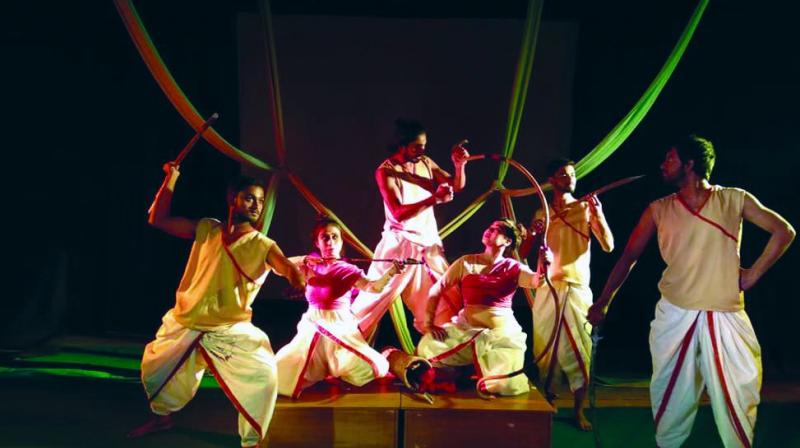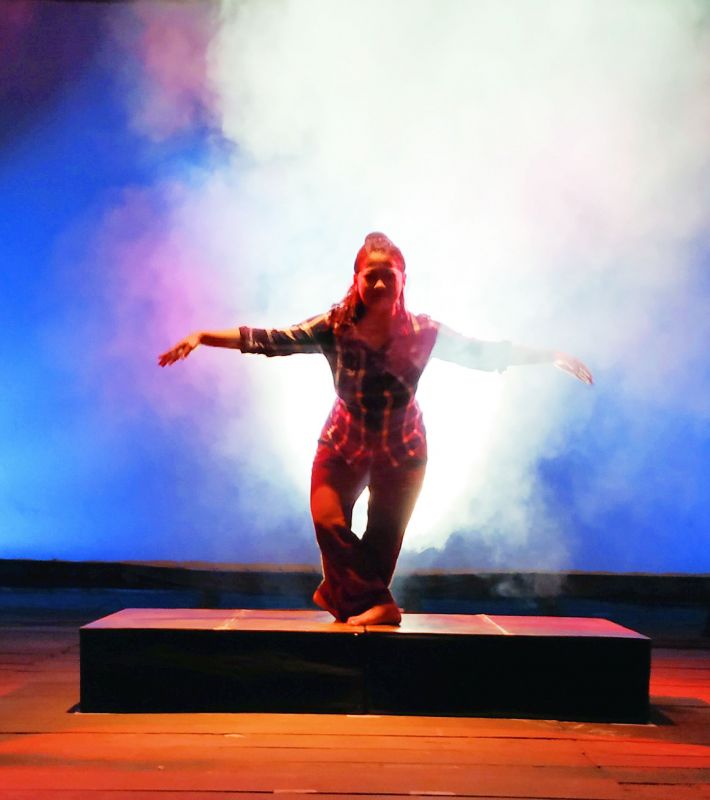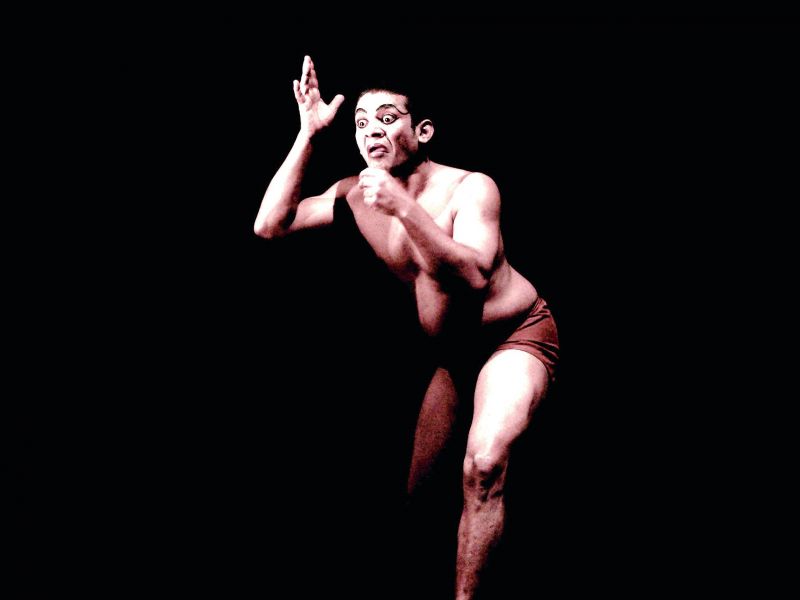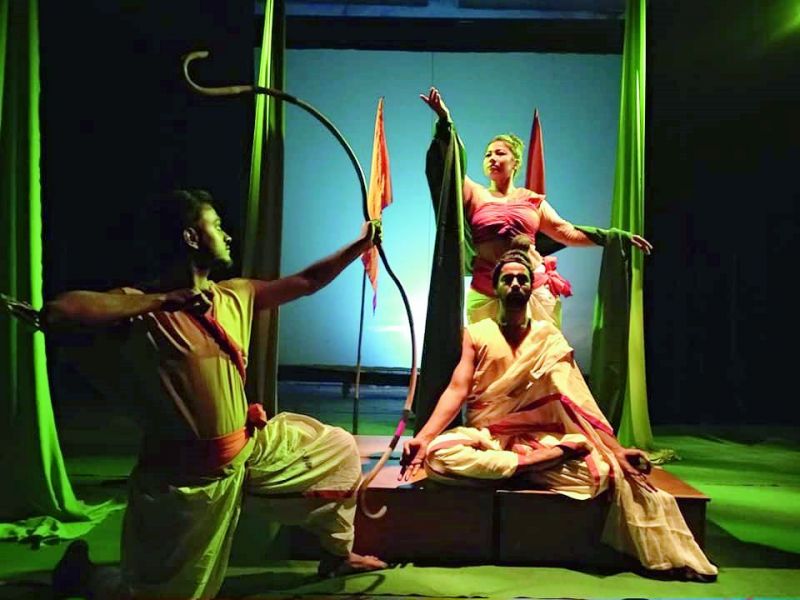Making a grand gesture
In India, artistic experimentation often reaches new dimensions and adding to this novel list is the evolution of physical theatre.

British theatre expert John Britton’s upcoming play in India—Whirlpool— is an experiment in physical movements and departs from the conventional style of storytelling – through dialogues and stories. Creating author George Orwell’s surveillance state through body movements, it explores life in the age of internet and social media surveillance. And John’s way of pursuing physical theatre is open, curious, creative and engaging. “We are all trying to find vibrant and fresh ways of telling important stories to live audiences,” says the director and adds that each artist brings a distinct skill to the play. “The work is physical not only because of using non-verbal means to communicate meaning, but because everything in the development of the performance is considered first from the perspective of ‘what is the performer doing with her or his body in this moment?” he adds.
 Play Mrigayagatha
Play Mrigayagatha
Across the country, artists are finding newer ways to tell their stories on stage. And while they may rely on complex light and sound design, tropes and extravagant backdrops, there are many who are using their bodies to put forth a performance, making ‘physical theatre’ one of the most evolving forms of theatre. John who has been organising workshops across India over many years feels that artists are now willing to step out of the convention medium of storytelling. “When people ask me what ‘physical theatre’ is, I have to say that there is no easy answer to that either. There are two key approaches to developing a physical performance. One is based on learning skills – you learn acrobatics and do an acrobatics show, you learn physical clowning and perform a physical clowning show. The second is more complex and it is where my work comes from. This second approach understands that everything the body does comes initially from the mind. We have to train the mind to be calm and disciplined, responding only to the impulses that require response - and if we can do that, that is what will appear in the performer’s body, and is what the audience will see,” says John, who is the founder and director of The DUENDE School of Ensemble Physical Theatre in London.
 Scene from the Play Football by Mimers Trivandrum
Scene from the Play Football by Mimers Trivandrum
Decoding the metaphors
While the form has returned to public consciousness in the last few years, the roots of physical theatre can be traced back to the Stone Age, when humans mostly used sign language to communicate. During that pre-historic period, the cavemen would retell stories about their hunting adventures through their body movements. “They used to communicate through body and facial expression; there was no language. Sharing hunting stories by the evening campfire was a way of theatre and entertainment for those aboriginals,” explains Sabyasachi Dutta of Jalpaiguri Sristi Mime Theatre, adding that physical theatre was the first form of theatre and the use of language was incorporated, much later. In India, various folk and martial arts performers have explored movements in performance and a few physical theatre practitioners observe that the second phase of non-verbal theatre grew in southern and eastern parts of India. Some of the folk forms such as Kalaripayattu from Tamil Nadu, Koodiyattam of Kerala, Yakshagana from Karnataka are largely performed using body movements. It is only in 19th century that contemporary theatrics have started including physical movements in their performances. “It is a second phase of physical theatre, because most of the movements in India and abroad are inspired by these folk arts and Natya Shastra,” adds Sabyasachi.
 Scene from Brhannala
Scene from Brhannala
In 1960-70s, veteran theatre director, Ratan Thiyam from Manipur mastered the art of physical theatre in his productions. For him, the actor’s body is a major tool of expression. He used and still uses martial and folk-art form from North East in all his performances while keeping language as a secondary mode of expression. “Ratan Thiyam’s productions are a mix of Manipuri folk art, visuals and text. They create a visual blend on stage and one could see the use of body movements flawlessly,” says veteran theatre director and critic Abhishek Goswami of Azim Premji Foundation. The veteran director has used the martial art form known as Thang-Ta in his plays such as Urubhangam of Sanskrit playwright Bhasa, and Chakravyuh, often considered one of his finest works.
According to Abhishek, the trend of using body movements in contemporary performances only evolved when in 1960s-70s, Polish theatre director Jerzy Marian Grotowski coined the term ‘poor theatre’ – a performance style that rid itself of the excess of theatre, such as costumes and lavish sets. “People studied Grotowski’s theatre and found that it has its roots in Indian Kalaripayattu. Gradually, they started using this form in their theatre productions,” says Abhishek.
Since then, many theatre directors have attempted this form of ‘poor theatre’ in their productions. Poor theatre grew due to economic crisis in late 1950s, when theatrics couldn’t afford to have properties and heavy sets and hence found it wiser to use the actor’s body as a primary tool of communication. At that time, body movements were integrated with dialogues and it was believed that both could go hand in hand. “Though Grotowski’s form of physical theatre creates visuals narrative through body movements, he never discarded the use of dialogues. However, in contemporary theatre, many theatrics are separating movements from text,” rues the director.
Apparently, Indian Natya Shashtra also inspired Grotowski’s physical theatre. “His work and idea of physical theatre is very much inspired by Indian folk forms,” confirms Anand Vidhaat Sharma, who studied physical theatre at the Grotowski Institute in Wroclaw, in Poland. Anand informs that when Grotowski came to India for the first time in late 60s, he was very inspired by the Indian folk forms, “He was also concerned about theatre’s survival in the age of cinema and hence focused on minimalism of special effects and the maximum use of actor’s body and expression.”
 Scene form the play Whirlpool
Scene form the play Whirlpool
Artistic influences
From the Greek chorus to Commedia dell’arte to Japanese Noh theatre, Butoh theatre and Chinese Tai Chi – a form of defence martial art, Indian theatrics are now adapting the key elements from their western counterparts in their storytelling pieces. Gagan Shrivastav, who is learning the Japanese art form Butoh at Himalaya SubBody Butoh Scool in Dharmsala, explains this way of performance is known as an art of Shisha, which means ‘body of a dead that can transform into anything’.
“Butoh has no construction and performance style, it only follows the movements and sounds of the body. It is a kind of abstract art, which helps the artist to express his own lost memories,” says Gagan. For him, it takes a lot of time to perform Butoh because one has to understand the body’s feelings. “One has to follow the sensations of the body and that’s how an actor learns to explore his learning in performance. It has very less communication to the audience because it’s an abstract art,” says Gagan, who is also a National School of Drama alumnus.
Vishal Chaudhry who has been performing Butoh for last five years says that the form is good for actors’ evolvement because it has more to do with actors body and mind journey. “In India Butoh has been embraced by the young generation more than performers Japan. The only training school of Butoh is in India and that shows that people are accepting the newer ways of performing art,” says Vishal, who recently performed a Butoh act – Loosing Identity that talks about individuality above any religion.
This form of theatre, at times, also incorporates other techniques such as gestures, modern dance and mime to create performances. Commedia Dell’arte’s Mask and Physical Theatre is being taught at Indianostrum, in Pondicherry for the last three years. “This form is yet to make its space in India because so far, it is only taught in Pondicherry but soon, the students will experiment with their individual performance,” insists Vishal. Apart from Commedia del'arte and Butoh, Clown and mime theatre is also been adapted as a popular form of physical theatre in India. Niranjan Goswami, the director of Indian Mime Theatre and National Mime Institute in Kolkata, believes that Mime is the only such form that uses the full body in performance with no help of dialogues and properties. “Mime is based on Natya Shashtra which talks about body movements and actors convey stories through their body movements. It is through proper training and techniques that one acquires the ability to perform mime because you don’t have any support of words or properties,” explains the director, who is also a recipient of Padma Shree award in 2009
Breaking language barriers
Over the years, there’s a debate among theatre practitioners whether physical theatre can be text inclusive or have its performance solely based on body movements. For Bhopal-based theatre practitioner and director of Shadow Theatre Group, Manoj Nair, it is about breaking the barriers of language and making theatre performances understandable to everyone. “Since you don’t have language, anyone can understand what the artist is trying to portray on the stage. If a traditional play from North India is performed in South India, then there may be a language barrier but with Mime or any form of physical theatre, that challenge is not there,” says Manoj, who directs non-verbal performances using colours and structures. “The performances are universal as these themes help in reaching out to a larger number of audiences than dialogues,” explains the director who has also experimented with many strong text-based performances such as Jeb Katra by Manto, Macbeth by Shakespeare (he explored physical movements using key points of the script). Similarly, Sabyasachi also believes that non-verbal performances are universal and don’t require any specific language to be understood, “We can also explore more aspects of performance and have many performances in different parts of the country without the baggage of language.”
Some of the recent contemporary performances such Andha Yug by Jayant Nitai, Kalo Sonakhari (Black Orchid) by Abhilash Pillai, and Prabhath Bhaskaran’s re-visioned Samuel Beckett’s Act Without Words 1 and Act Without Words 2, explore the idea of physical pain in various forms. “In these performances, the body carries emotions and thoughts throughout the performance and that’s what physical theatre is all about,” observes Abhishek.
However, Anand believes that in India, theatre practitioners are missing out on the basic points of physical theatre. “Jumping in between the performance and adding some somersaults to it doesn’t make it a physical theatre performance,” asserts Anand and adds, “It is about finding the truth away from the classical form of performing. It is to become a bridge between the imagination and reality.” One of the pioneers of contemporary theatre the country, using body language as the primary mode of storytelling on stage, is Adishakti Theatre group from Pondicherry. For Vinay Kumar, the artistic director and actor of the group, physical theatre is not new to the country and has always been there in its indigenous form. “We have a misconception that physical theatre is some different entity. No, it’s not true, the body moves first and then the text comes. Physical theatre doesn’t mean one has to be all the time physically charged, it is about being active and knowing your body, being conscious,” says the actor.
Playing by the ear
While many are warmly embracing the new ways of stage performance, a number of theatre practitioners prefer to adhere to the traditional forms of storytelling. Unveiling the reason John says, people settle into what they know because they have spent a lifetime trying to become excellent in their ways of performing. “Of course, we resist, because we have mastered a way of performing. However, it is equally important that each generation brings a restless new vision to the art form. Young and old, trained and untrained, should realise that none of us know very much, and art is best served by finding creative collaboration between dissenting and sometimes conflicting perspectives,” believes the director. However veteran theatre director Quasar Padamsee who works in relative tradition of text based and interactive theatre, believes that it is about what you know and do best. “Physical activity and text, both go hand-in-hand in a performance. It is more of first impulse of the practitioner, whether he wants to use body or text. Theatre is becoming more versatile in its presentation and text can’t be excluded from physical theatre as well, says the director and adds, that young people are going abroad and learning physical theatre and including that in their presentation, “which is good but one can’t ignore the importance of text based theatre.”
Agreeing upon Quasar’s thoughts, Manoj says that every theatre practitioner has his own zone and no one should try something new just because of the trend. “People have mastered their way of art. They have clarity in their dialogues and dictions, which is the basic of theatre. Nonverbal and verbal both the theatre forms are important else what would remain for those who like watching verbal theatre,” says Manoj, confirming that there are theatrics who are using both the forms of theatre in their productions. But understanding the mechanics of physical energy and the ways to deal with notions of rhythm and body requires an elite class of audience. “You need an intelligent audience to decode the metaphors and symbols in the performance. Physical theatre is a different level of performance and it is hierarchical in its form which builds a relation between spectator and performer, so it needs a different kind of audience,” says Vinay. On the other hand, Niranjan assures that there has always been an audience for physical theatre. “Mime performances develop an interest in the audience to know what story the artist is going to unfold. With body movements, it becomes more intriguing in its presentation and keeps the audience inclined.” On the other hand, John is of the opinion that though some will find challenging many more will find it exciting, “There is an audience who find physical theatre exciting, encountering, vibrant and living.”

